| Author | Message | ||
Al_lighton |
S3 Saddlebag repair S3 Saddlebags look pretty nice when mounted on the bike, but the mounting method leaves a lot to be desired. The inner part of the bags are made of ABS plastic, and the bags "hang" on indentations molded into that ABS. Metal/plastic draw latches keep the bags from coming off those indentations, but they don't take much of the load, the ABS does. They do, however, concentrate the load points and provide some stress risers, so it is common for the bags to crack at the latches. In addition, there are only 3 latches and a fourth bumper. Early bags didn't reinforce that bumper area and the result was usually a hole worn right thru the ABS plastic from the bumper. As the bag flexes, the ABS is overstressed and cracks occur at the latch points. Buell has replaced many failed inners, but it apparently is difficult to get these replacement parts now. And if you aren't the original owner under warranty, forget it, it isn't going to happen. If you try to buy them, get ready for some serious sticker shock. So, this article details how I went about fixing Reindogs (Tom) and my saddlebags by fiberglassing the inside as a doubler. I did this as a result of a suggestion by Steve Slaughter, and I'm pleased with the results. I should note that only my right bag was damaged, but I highly recommmend doing this to all bags BEFORE the bag fails/cracks. First, here are some pictures of the typical damage. My bags came from a cheat on ebay who didn't tell me about the damage. The rear bumper plate on the right bag was missing, and the bag was very cracked up at the corner near the bumper. Hard to tell from the pics, but these cracks are all the way thru and splintered. I formed it with my fingers as close to the original shape as possible.  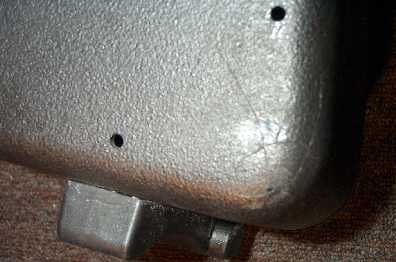 My right bag had a single crack radiating out from the front cam latch. I accented it a little in the picture to make it more visible.  Tom's bag was very cracked up at the rear latch. Several cracks radiated from his latch. We found some other cracks not visible in this picture as well.  To repair, first remove all the hardware. I even removed the latching plates (that hold the outer bags closed to the inner bag) from my bags, but we did Tom's without removing those. Certainly the cam latches that mount the bags to the bike all must come out, as well as the bumper plates. You MIGHT be able to drill out the rivets holding on the bumper plates:  But most likely, the rivet will start spinning and you won't get it out this way. I used a grinder to grind the swelled head off the rivet.  Next, sand/scotchbright the entire inside surface that will be glassed. This is to provide a surface that the resin can adhere to. Wash out the inside to remove all the dust and grease and such afterwards. Use soap, you want these surfaces squeaky clean. You can see the crack in my bag in the second picture. More scotchbrighting is needed there to guarantee adhesion.   Next, tape up the latch holes and cracks on the back side with masking tape so that the resin can't escape.  The goal here is to provide a single layer of glass over the entire mounting surface, and a couple more layers at the stress points. However, the cam latches have a fixed grip length. If you build up the thickness more than a few layers, the latches won't have enough grip length. The factory counterbores the latch mounting point to make it flat and the right thickness (see two pictures up), and this contributes to the cracking problem. We can't do that here or we'll lose the strength we add. So don't use more than 3 layers. I used epoxy resin obtained from a marine store. The stuff is expensive, about $65 a gallon with $20 additional for a quart of catalyst. I read elsewhere that the much cheaper polyester resins ($25/gallon at home depot) MAY work better because they will melt into the ABS a little. I was scared of melting too much of my saddlebags, so I used the epoxy. The epoxy resins are generally stronger and less brittle, I've read. There are different weights of glass cloth, I can't tell you what I used here, but it was the medium weight stuff at the marine supply place. Use woven cloth, not random fiber mat, because it's thinner. I cut a few small pieces for reinforcing the latch points, then put one big piece in as a continuous doubler. you want to put the small pieces UNDER the large single doubler piece of cloth, because as you wet it out, some fibers will fray on the edges. Having the loose pieces under minimizes the fraying.  After laying all the glass in place, I mixed up the resin. I used measuring cups to get the ratios right, but for $20, you can get pumps that properly dispense the right ratios. I would get that if I did it again.  I used large ziplock freezer bags for mixing the resin. Pour the two parts resin in the bag, and kneed it thoroughly to get the mixture completely mixed. This is a great way to get thorough mixing and it doesn't make a mess, you just throw away the bag of what you don't use. Now pour the resin into the saddlebag. Two people help here, one to pour, and the other to work it in. The goal is to get the glass mat completely wetted out, and completely against the plastic surface with no air bubbles or ridges. It's difficult to get it completely seated in the right angle corners, do the best you can. USE RUBBER GLOVES. This stuff is NOT good for your skin, severe allergic reactions can result. Some people are so allergic to this stuff they will get a rash if they're even near it, but that's rare.    In a perfect world, the whole mess would get a peel ply put over the fully wetted out mat, and then the surface would be "vacuum-bagged". This is just a plastic bag that is evacuated, causing the atmospheric pressure to force the excess resin up into the peel ply. After curing, the peel ply is removed, taking the excess resin with it and leaving a reasonable surface. The vacuum bagging adds strength. But I did none of this. I just used lots of paper towels to blot out the excess resin. The excess resin will add little strength, but adds weight, so do the blotting until you can see the cloth texture. It is easier to wet it out with excess resin, and then remove the excess with the paper towels, than it is to put just the right amount in to start with.  At this point it's ready to cure for 24 hours. What it looks like now will be what it looks like when it's cured, so make sure you're happy with it. After curing, there will be little bumps and SHARP glass splinters that may be sticking up. A dremel tool will make quick work of them. Be careful, they will slice you (or your bag liners) good until you remove them with a sander.  After I did all this, I came up with a brainstorm. The molded in ABS ridge that the saddlebag hangs on forms a little trough inside the bag. Nothing gets stored there, it's dead space. I figure that anything that could be done to reinforce that ridge is a good thing. So I bought a short length of nylon rope, mixed up some resin in the bag and worked it into the rope as best I could. I then laid the rope in the trough, and then filled it with resin all around it. It adds a little weight, but makes the bag extremely rigid in this area. If I had it to do over again, I would have put the rope in at the same time I laid in the cloth. But I did it as a second step 24 hours after the doubler layers cured, after roughing the surface of the doubler layers up a bit. Note the paper towel "dam" to keep the resin in the tough with the rope.   After all cured, you just reinstall the cam latches and drill/mount the bumper doubler plates with a pop rivetool. Note, however, that getting the cam latch plates (the ones that engage the mounting frame on the bike) in the right position on the threaded shaft takes some adjusting work, and that the additional thickness of the glass may force you to eliminate the lock washers to get them as far out on the threaded shaft as possible. I HIGHLY recommend using red loctite on the nuts that retain those cam plates. In the next installment, I'll show how to make the bumper section work better, per the tip provided on the ATC site. Al edited by al_lighton on August 05, 2003 | ||
Kinger |
Great write up Al! I modified my bumper plates before a trip last month and have been happy with the results. I think I will need to reinforce my bag as you have described and I should be ready to go. Thanks for the great explanation! | ||
Ccryder |
Al: You-da-Man. I went thru 3 sets of inners b4 I traded Sparky for Stripe'r (in 2000). My last set had to be overnighted 2 days before home comming so I could ride to WI. Thanks to Anon R. it all came together and got me a prime seat at the "Technical Safety Check" at the factory. Time2Work Neil S. | ||
Al_lighton |
S3 Saddle bag Mounting Fix In the last article, I showed how I repaired the cracked up plastic part of the inner saddlebags. One reason that they crack is because the stock ABS material isn't up to the task of carrying the load. However, if the load was static, they wouldn't fail. They fail because the bags are bouncing all over the place as the bike rides over bumpy roads, all the while being shaken by the v-twin paint-mixer of an engine that we all bought a Buell for. All this bag bouncing occurs because the three latching points allow too much freedom of motion. The fourth support is just a bumper at the bottom back corner. You can decrease the amount of bounce by increasing the bumper pre-load, but then you end up overstressing the other three mounting points. On the ATC site, in the tech tips section located at http://www.americanthunderbike.org/techtips/s3bagfix.php , Don Cichocki recognized all the above and came up with the idea that the bumper should be turned into a 4th mounting point, with bolts running thru welded-on aluminum standoffs. I think his fix is really good and should fix the problem, but I was out of time to get the bags ready for a trip, and I don't have easy access to an aluminum welder. So I incorporated the concept into a slightly easier to fabricate fix. The first part of the fix is to make bigger load spreading plates. Like Don's, I made 4 instead of two, and put them on both the inside AND the outside of the bag. Plates on the outside only (like stock) would probably work, but it wasn't that hard to make 4 identical plates with the shear at work. Maybe I'd feel different if I was cutting them with a hacksaw at home  ">"> ">"> This picture shows the inside plate. : 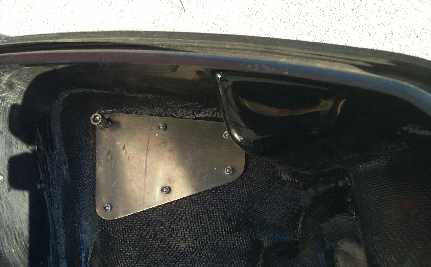 I just cut a piece of paper to use as the template for making the plates. The shape of the plate isn't so critical, but be careful about it fitting flat inside the bag corner radius. Be sure to get the edge of the plate as close to the bottom back corner of the saddlebag as the inside corner radius of the bag will allow. The location of the 5 rivet mounting holes isn't critical either. But the holes must line up. I did that by clamping all 4 plates together and drilling them at the same time on a drill press, completely by eye, no measuring required. Note, however, that the 6th hole that the mounting bolt will go thru will not be drilled until the plates are already mounted to the bags. That hole must be very carefully aligned with the bumper frame below the license plate. This is the outside plate. : 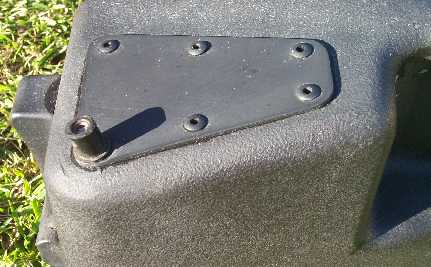 Position the outside plate on the saddlebag, and use it as a drill template for drilling the 5 holes thru the plastic and fiberglass. Make sure that the inside plate will sit flat on the inside, and not be riding up on the bag inside radius when you position the outside plate for drilling. Attach the plates inside and out to the bag using 5 poprivets. I used 3/16" aluminum pop rivets, but 1/8 or 5/32 would probably work fine too. The 6th hole for the mounting bolt needs to be marked with the bag mounted on the bike. Remove the stock bumper, thread a socket head 1/4-20 screw all the way into the female thread on the bumper frame. Mount the bag and tighten the cam latches as normal , and then back the bolt out until it contacts the bag and gives it about 1/16"-1/8"of preload. Do not over preload! Trace around the head of the bolt with a sharpie. Before removing the bag, note that the angle of the bag relative to the axis of the 1/4-20 bolt isn't perpendicular. Make a mental note of the approximate angle. Also, measure the gap between the plate and the bumper frame (i.e., the length of the exposed bolt, head included) Remove the bag, and drill the center of that mark with a 9/32" drill bit, trying to emulate the angle that you saw the bolt at. It isn't really critical to get that angle perfect. It would probably work if you did it at a right angle to the plate, but you may need to enlarge the hole a little if you do. Better to get it close to the correct angle. Remove the 1/4-20 bolt. Rather than weld on an aluminum spacer the way Don did, I just used a 1/4-20 rubber Well-Nut, threaded onto the mounting bolt. If your bags are closer than the length of the well-nut, you can slice some length from the non-threaded end of the well nut. Conversely, if the gap is longer than the well-nut, add a rubber washer or two. Note that 1/4-20 well nuts are available with a few different grip lengths, so you might be able to find one that is the perfect length. I found all kinds of rubber spacers/washers, and the well nuts, at a local very cool HW store. I just inserted the appropriate length bolt from the inside, threaded the well nut on loosely, and the bag is ready to mount. Thread it on too tight, and the bolt won't easiy spin and it wil start to compres the well nut. Thread it on too loosely, and it really isn't retaining the bag well enough. It will make sense as you tighten it the first time. This picture shows the right bag well-nut in the loose position on the bag. :  Here is the right bag mounted and snugged. : 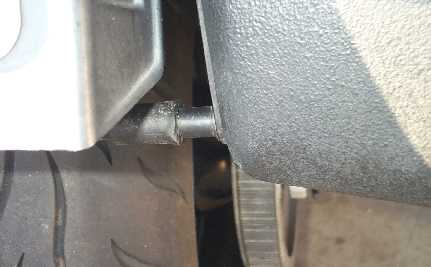 Here is the left bag mounted. Note that you want to maintain that distance that you measured earlier, so have those lengths with you when you're searching the HW store for the right well-nuts/rubber spacers. My left and right side were not een close to the same distance. The right side used just a well-nut, the left needed a longer grip well-nut PLUS a rubber spacer. Yours will likely be different. : 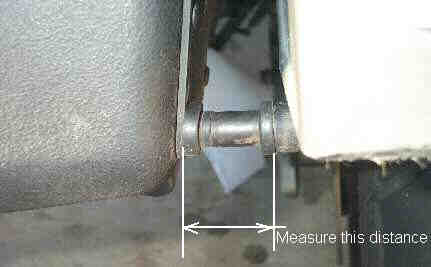 To mount the bags, hang them using the latches normally, with the new bolts backed almost out. Then loosen the cam draw latches so the bag can move around a little, and get the bolt threaded into the bumper frame most of the way, but leave things a little loose. Tighten the cam latches, then snug up the bolt. Do not over compress the well nut, just make it snug. I didn't bother making knobs for the bolts, I just use an allen wrench. I tend to mount my bags for big trips, and leave them on the bike for the trip, and then remove them when the trip is over. If you want to be able to take them on and off easily, with no tools, adding a knob would probably be a good idea. However, there isn't much finger room for a knob, and the bumper frame determines the bolt position, not finger clearance. I don't have a long term test to say all this works, but it survived the 2600 mile SPLASH trip, and I was on a lot of ROUGH gravel roads, and everything is as it was when I did the job, no cracks yet. I have no doubt it is better than the stock arrangement, and it's pretty easy to make. Al edited by al_lighton on August 08, 2003 | ||
Kinger |
I took the plunge and attempted the repair as described above. Overall I think it went pretty well. Al's instructions are very detailed and point out areas where you might slip up. I was able to find the resin and hardner at a marina as suggested. As you can see from the pictures below, I didn't do a good enough job getting all of the excess resin out or the air bubbles. I think this will work and I will be giving my newly reinforced saddle bags a road test this weekend. 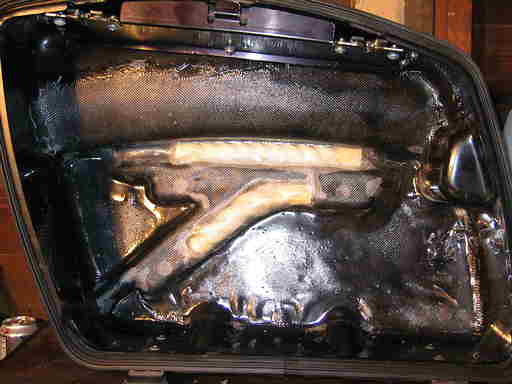 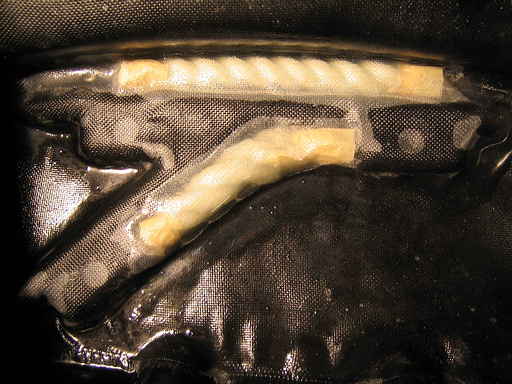 edited by kinger on May 12, 2004 | ||
Al_lighton |
Lookin good, Aaron. Have you fitted the latches yet? That part will take some patience, as there really isn't as much grip length as would be optimum on the draw latch thread. You may find that you need to eliminate lock washers on one or two of them, just use lots of red loctite and you'll be fine. Make sure you inspect the edges for any burrs and grind them down. They can be very sharp, I sliced my finger real nice on one of them, and I'm sure they'd do the same to the inner bag if left there. Al edited by al_lighton on May 12, 2004 | ||
Kinger |
I fit one set of the latches last night. I will be finishing up the latches and reinstalling the corner mount between tonight and tomorrow (nothing like waiting until the last minute before a trip!). The latches seem to be fitting okay. I did have to remove the locker washer, but I have a brand new tube of red loctite! How tight should the latches be when all three are engaged on the bike? I am thinking that the tighter the better, but I don't want to induced to much stress by having them to tight. I ground down the inside of the bags already. I am planning on double checking some spots to make sure they are smooth. Thanks again for the tips and great write up! | ||
Al_lighton |
Aaron, If you can operate the latch, they aren't too tight. If they are too tight, the latch won't cam over without so much force that it feels like the latch will break. Tight good, loose bad. Al | ||
5liter |
Mine are doing the exact same thing. I just discovered it this weekend. Oh well........ Time to lay up some glass!!!! | ||
Terrycoxusa |
A recent post to an old article. When working with fiberglass, use only enough resin to saturate the glass, it's the glass that gives the strength. | ||
Xl1200r |
Another tip for easy measuring... use something small, like a tablespoon, and measure out, with water, the correct ratio of hardener into a plastic cup, then mark on your stir stick how far up the water came. Then, add the correct amount of water for the resin and mark it again. Now you can use the stick measure and you'll be able to make quick, small batches without buying fancy pumps. This is nice because the resin hardens faster when in a big vessel (like a cup or bucket) than it does when it's spread thin. Small batches will give you more working time. | ||
Xl1200r |
I just finished this and have some other pointers worth adding. 1 - It takes some patience, but it is possible to use a single peice of cloth to cover the latch area rather than working in a collection of smaller peices. I have no idea if this is stronger but the result is a cleaner appearance. I put a small peice of cloth in where Al put the section of rope, another layer that covered the entire latch area and a small peice over the bumper plate corner, and a final layer that covered everything. 2 - Get a stiff-bristled brush to work the resin instead of pouring it in and sopping it up with paper towels. You don't need much resin - I think I used around 1/4 cup for each bag. This is much less messy than pouring it in. 3 - You can still use the lock washers if you put them under the latch tab rather than on top (like from the factory). I'd still use loc-tite, though. 4 - 4th mounting point is an EXCELLENT idea and does wonders to stabilize the bag. I did not remove the factory plate on the outside of the case. I removed the bumpers, drilled a hole in the case and threaded in a button-head bolt with a fender washer. I used a very short section of 1/4" fuel line cut at an angle to make up the angle different at the bolt head, and another section of fuel line slipped over the bolt thread between the bag and mounting bracket to work as a spacer. This bolt doesn't need to be tight - just snugged up so it keeps that corner from bouncing around. I'm really happy with how this turned out. |